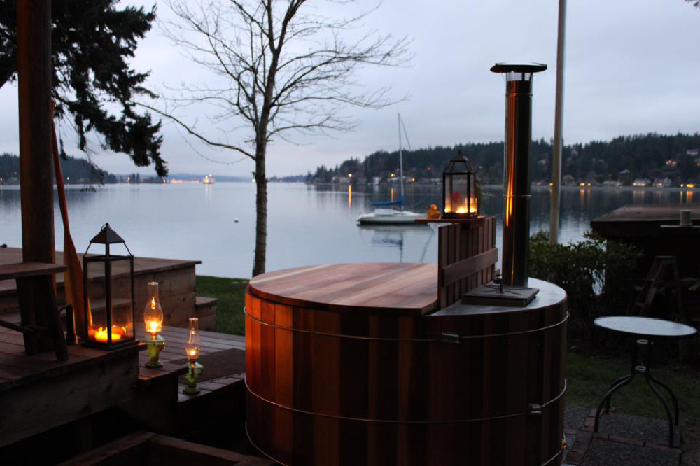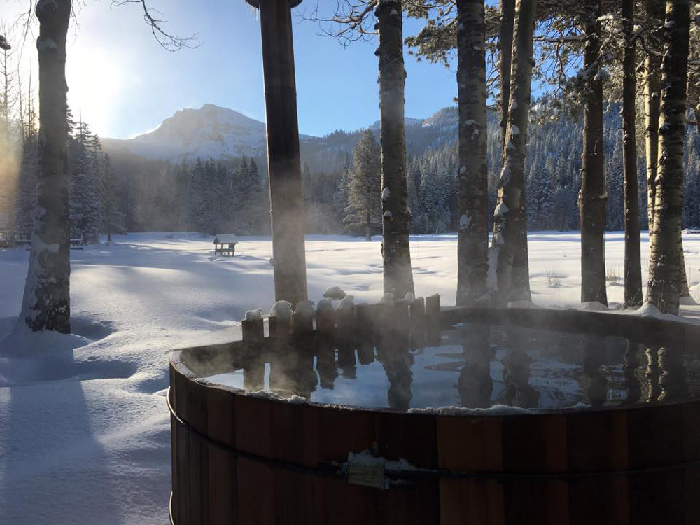Wood-Fired Hot Tubbing – a Lifestyle Choice

Choosing a wood-fired hot tub is definitely a lifestyle choice. Choosing between a wood-fired hot tub and a gas or electric heated hot tub is similar to the choice between a sailboat and a power boat. In one case you simply turn on the engine and power your way to wherever you want to go. With the sailboat you are involved in the process. It may take a little more planning and effort, but sailors find the process as rewarding as the destination.
With a wood-fired hot tub, you have to do some advance planning. You have to have some idea of the temperature of the water and the heating rate of the stove. Then you have to start the fire far enough in advance so the tub is ready when you want to use it.
One of our hot tub owners referred to the process as a “ritual” in a New York Times article on wood-fired hot tubbing.
“It’s fun, like a ritual that you plan hours in advance,” “You chop the wood, get the firebox going and get really good at managing the fire to keep the water in a narrow range of 104 to 106 degrees. You have a real outdoor experience.” Read more here.
There is certainly more effort involved in having a wood-fired tub, but the effort provides some unique rewards. When you get in you have the satisfaction of knowing it is something you created. The crackling fire and hint of wood smoke give a primal sense of comfort and memories of childhood campfires. You can even toast marshmallows while tubbing.
While we love our wood-fired cedar hot tubs, we know that they don’t fit well in a dense urban environment or the needs of people on the go. That’s why we also offer our wood hot tubs with the most complete gas and electric heat options you can find. Our version of a power boat equivalent in the above analogy. However you choose to heat your hot tub, the luxurious soaking warmth is there for you.

Wood–Fired Hot Tubbing is Fun!
Many of our wood-fired hot tub owners seem to have a bit more fun loving approach to things and a little extra edge of creativity. It may be that the experience brings it on them or, more likely, wood-fired hot tubs attract that kind of personality.
Heating is Simple
Build a fire like you would in a fireplace or any other wood stove, crumpled paper, kindling and then small or well split firewood.. Light the paper and place the stove door to provide maximum draft. Once you have a good fire going you can fill up the firebox with wood.
We recommend using cordwood that has been split one more time. This allows the fire to burn faster and heat the water more quickly. Heating times can vary depending on many factors such as the size, dryness, and specie of wood, the size of the fire and how frequently it is fed, ambient wind and temperature, whether the tub has an insulating cover, etc. Generally, our most popular combination, a 6′ x 3′ tub with the Snorkel® Stove will heat at the rate of about 31° per hour with a cover on the tub and good dried softwood for fuel.
Controlling Temperature
Controlling the temperature of water in the tub is really simple. It is much like the process of controlling the temperature of the water when filling a bathtub for a warm bath. The difference is instead of checking the water periodically and adjusting the hot and cold water entering the tub, you are checking the temperature of the water periodically and deciding whether or not to add more wood to the fire. After you have done it once or twice it will become second nature to you. Overshoot the temperature? Just add some water from the hose to cool down the tub.
Underwater Inside the Tub Stove v. External Stoves
We are probably biased in our preference for the in-tub underwater stove, but we also developed an outside the woodstove in the mid 80s. We offered it for sale for a few years, but concluded that, even though it was quite large, it was too slow to heat and too expensive to effectively compete with the Snorkel and Scuba Stoves. It was clear that the advantages of the in tub stove clearly out-weighed those of the external stove.
There are many advantages to an in the tub stove like the Snorkel:
It is far more efficient. It is made of aluminum which transfers heat 16 times faster than stainless steel. Almost every square inch of the stove is in direct contact with the water in the tub. There is no need for the thermos-siphon effect or other movement of the water. It produces 120,000 BTUs if you feed and tend it regularly with quality firewood.
Outside the tub stoves depend on the thermo-siphon effect to transfer the heated water to the tub. This is a slow in- efficient means of heat transfer. Hot tubs heated by gas or electricity depend on pumps to move the heated water to the tub. A thermo-siphon does work, but is a slow process.
Outside the tub stoves are subject to disastrous problems if there is a quick freeze that you have not prepared for. The water in the pipes will freeze and burst the pipes. Similarly, the water in the stove will freeze and will break the water jacket. Then you have to replace the pipes and the stove.
Outside the tub stoves require you to get down on your hands and knees in the mud/snow (unless you have a pad/ platform to kneel on) every time you want to start a fire or feed wood into the firebox.
An inside the tub stove does take up room in the tub, about one person. However, most of the room it takes up is unusable. Example: A 6′ diameter tub has almost 20′ of circumference. If you allowed 2′ for every person around the circumference, you should be able to get 10 people in it, but it isn’t practical.
The reason is because the seating is radial. Every person has their own pie shaped wedge and even with 5 or 6 people in a tub that size, their knees and feet are on crammed together as they are in the narrow part of the wedge. Yes, the stove takes up space, but from a practical standpoint the space lost is at most one person. The space the stove occupies really isn’t very usable.
